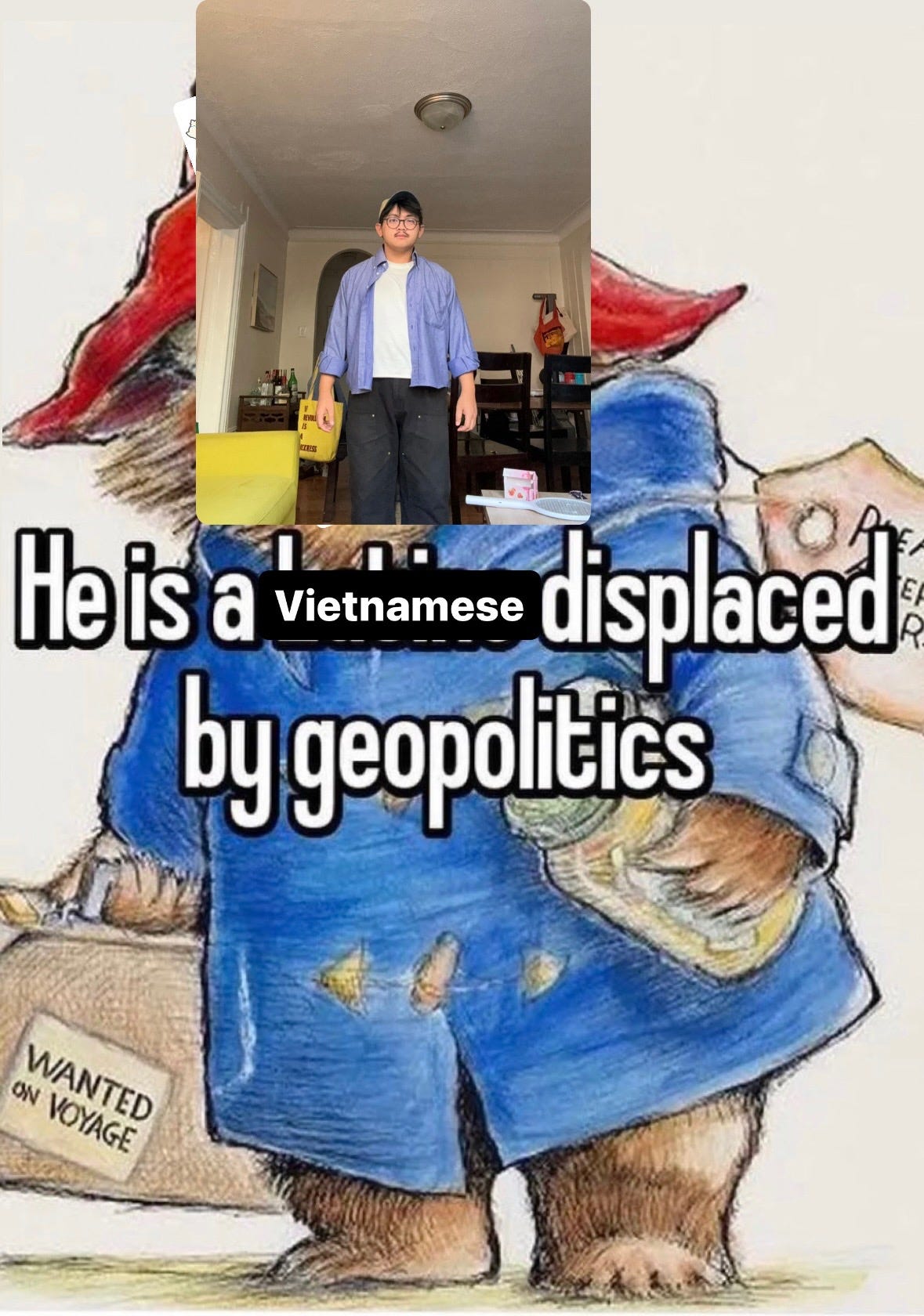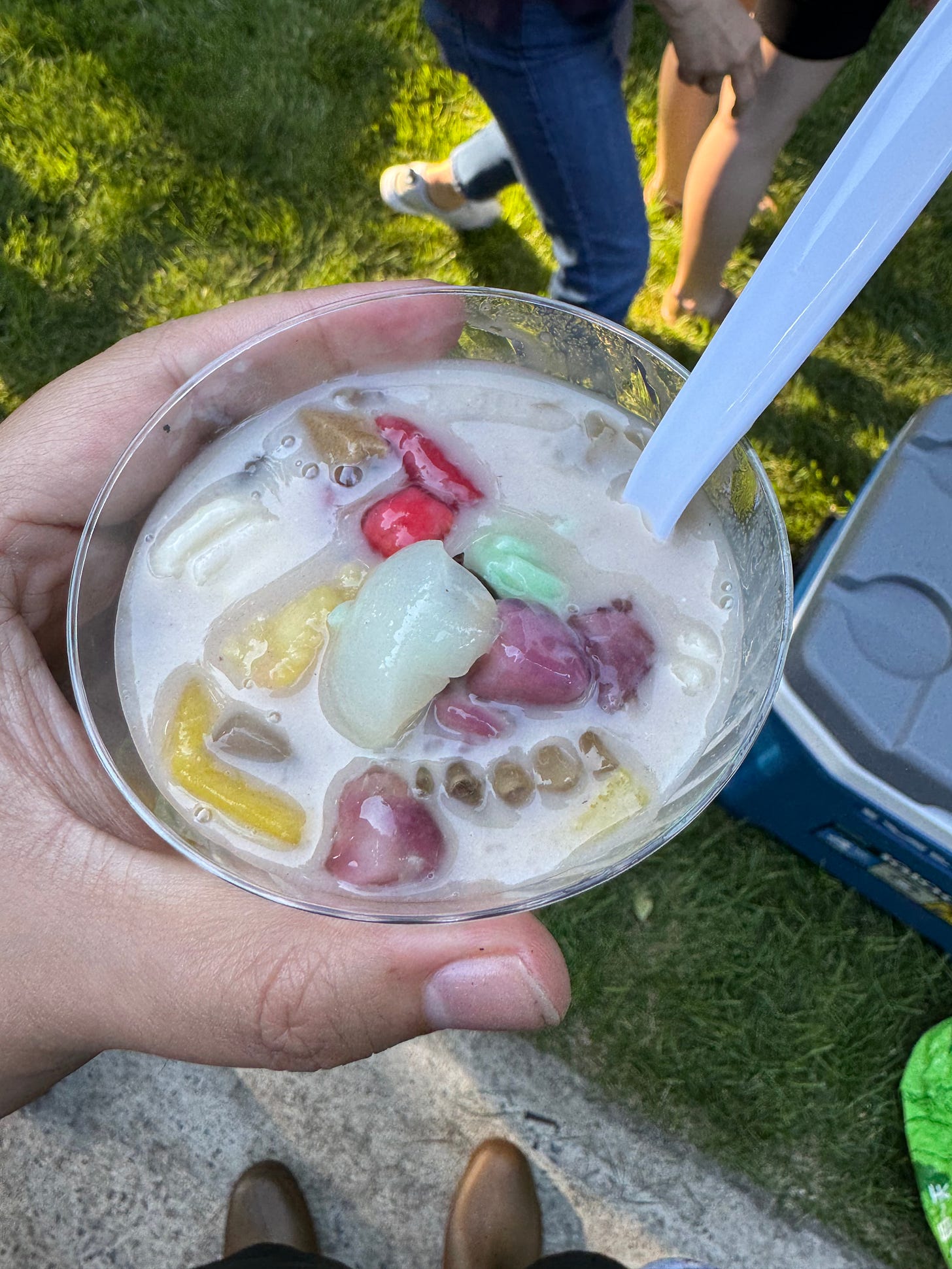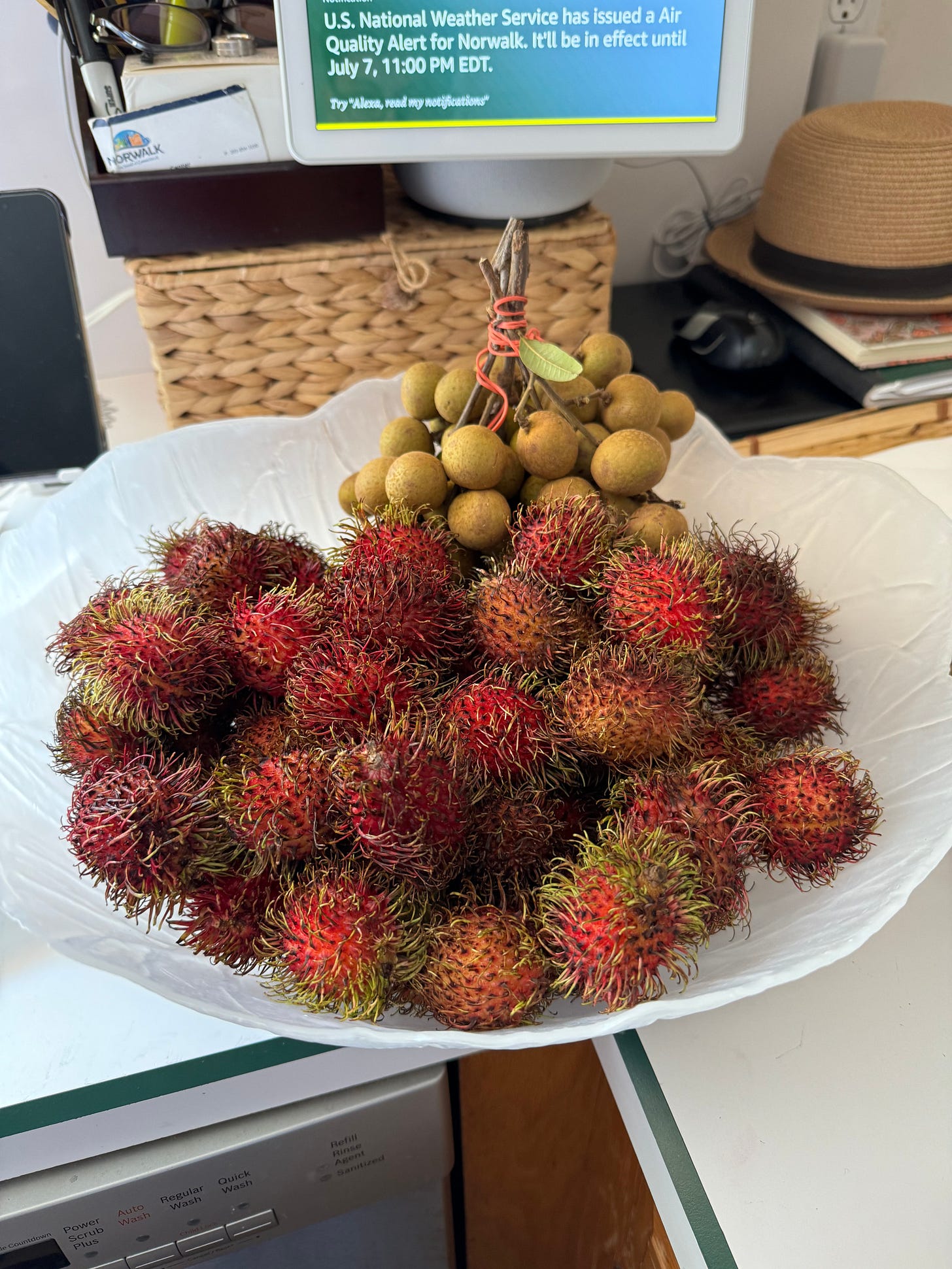On the "Vaguely Asian"
Observations on Vietnamese ambiance/ambience, Asian textures, and what comes of the pursuit of memory
Sorry for being gone for so long. Since the beginning of May, I’ve been trying to write something about Asian America. This took on many forms, many of them cynical about its current iteration and the commodification of identity that feels rampant. Over a thousand words in, I’d lose the plot, finding myself rambling on and on about everything I found wrong with our understanding of Asianness and what it’s become, ending up with the seedlings of an angry manifesto instead of a concise reportage of general vibes. I tried to tackle it all: racial grifting, bourgeois consumption habits that include what we eat and what we wear, the suspect capitalization of an Asian identity to hawk vaguely Pan-Asian products, the false promise of returning to your “homeland”, Asian fight videos, the general stagnancy of Asian American cultural production that leaves us in a vicious loop talking about the same topics for the past X years, the underlying self-hatred and self-tokenisation that pervades Asian Americans desperate for white acceptability. I could go on. And I did, which made me feel like I was losing my mind.
Getting caught up in the act of organizing and collecting my thoughts kept me plenty busy, and then life got plenty busy, and then I turned 27, and began freaking out about more typical things (aimlessly trudging through life, feeling the spectre of old age, disappointment at being unaccomplished). Then I took stock of life lived, and a perspective began to crystallize. These are my attempts to bring what exists at the periphery into focus, to bring forth that Asian subconscious that colors how we move through the world. I do a lot of circling from above, in search of something specific down below, and while I’m not quite sure if I ever get there, the act of circling seems central to the Asian American experience — always in search of an idea with ever-changing goalposts. If none of this rings true, then at least I have my measly observations.
****
I know next to nothing about the anthropological study of cuisine and how it develops. There’s probably an actual discipline, but in classic dumb-man fashion, I rely on my own intuition to think it through and consult none of the literature. When discussing food, I’ll often ask my friends if they think there’s a central philosophy or flavor profile that defines the cuisine of their culture. Often there are stereotypes at play: Korean flavors are more in-your-face, Japanese ones are more subtle, etc. When I think about what makes Vietnamese cuisine what it is, what comes to mind is a reliance on the environment, to use what’s around you, resulting in a collection of fresh herbs complementing rice or noodles, and meat and seafood if it’s available. Fish sauce, the lifeblood of most Vietnamese cooking, infuses these simple ingredients with umami, recontextualizing the food before you. Broadly speaking, you are living off the land.
But isn’t that the story of every food culture pre-globalization? You can’t use what you don’t have. I’m curious how supply chains affect the development of cuisine, diversifying what you’re able to work with, allowing you to take anything anywhere if you have the means to acquire what you want. Perhaps an obvious point when laid out like that.
More importantly, in the case of Vietnam, I wonder how imperialism butchers the traditions established over generations. Forced to take refuge in the arms of your instigator, faced with American slop, how do you translate the techniques you’ve picked up into an environment that doesn’t have what you need to cook?
****
For Father’s Day, I went back to my parents’ home for a family barbecue. Aunts and uncles and cousins gathered in the backyard, where my dad operated two grills simultaneously. The larger one, a simple circular charcoal grill, housed burgers and hot dogs on one half, and corn on the other, with a collection of toasted buns stacked on the edge to keep warm. The smaller grill, a portable stainless steel one hooked up to a propane tank, sat low on the ground sizzling ribs in a Vietnamese marinade that if I had to guess, consisted of lemongrass, shallots, a dash of fish sauce, and either sugar or honey for sweetness. One of my cousins grabbed a cob of corn, and scanned the table for scallion oil to brush over it before handing it to her toddler son. She said she had originally had corn with scallion oil at family gatherings, but now she always finds herself looking for it whenever she has corn on the cob.
You can find elote without too much searching in New York, but Vietnamese restaurants aren’t exactly throwing grilled corn brushed with scallion oil on all their menus the way you expect to find a bowl of pho. Maybe it’s too casual; after all, who would go to a restaurant to eat corn on the cob (ignoring the fact that we often pay for bread and oil)? Maybe it’s too casual, or not distinctly Vietnamese enough for a restaurant that must carry the burden of representing the entirety of a country’s culinary traditions, even if they only hail from a specific region. Maybe I’ve never seen it because it’s something only my own family did.1
****
I first came across the term “vaguely Asian” when reading about the artist collective CFGNY, an acronym for Concept Foreign Garments New York, or Cute Fucking Gay New York, depending on which interview you’re reading, after hearing about the fashion show they hosted at the Japan Society in January 2023. It’s a term they return to over and over in interviews, relying on its indefinability to resist any concrete definition and expand its applicability to our world and its materials. On their website, they say vaguely Asian is “an understanding of racial identity as a specific cultural experience combined with the experience of being perceived as other”. In America, where whiteness looms large even when it’s not in front of your face, we view ourselves as foreign, and exist in a constant state of flux as we inch closer to or away from that foundation. Whether you want to be a part of the club or not, whiteness is the control group from which you deviate.
Within this framework, many things around me started to appear “vaguely Asian”: frying your eggs in sesame oil, throwing chili crisp on a cold cut sandwich, offering your guests a pair of house slippers when they come into your home. When treated with delicate discernment, it becomes an interesting way to observe how a racial identity is developed through a collection of experiences and actions. At its worst, you end up with lowest common denominator humor that would’ve done numbers on the “subtle asian traits” facebook group in 2018. Nonetheless, I began to make sense of the textures of my own life, wondering what makes things explicitly Asian, vaguely Asian, or not Asian at all.
****
A few weeks ago, while driving back from the Poconos to New York, all of my passengers fell asleep, leaving me alone behind the wheel. I was tired, sweaty, and off an orange Celsius with hours to go on the road. With full control of the music and no one’s tastes to pander to, I put on a Spotify playlist I came across of Vietnamese bolero music. An offshoot of Cuban bolero, the music is slower and possesses a weighty, dramatic feel, with lyrics addressing matters of love, romance, and war. Banned in Vietnam after the fall of Saigon in 1975 for being considered a relic representative of the former Southern government, it gained popularity amongst overseas Vietnamese in the West, presumably because it reminded them of the home they left behind. Much of this can be attributed to Paris by Night, the Vietnamese variety show everywhere but in Vietnam, and the Video and DVD recordings that circulated like wildfire in Vietnamese communities around the world. Go to any Vietnamese home and you’ll find a stack of Paris By Night DVDs next to the black market karaoke machine that somehow has thousands of Vietnamese songs loaded up next to Elton John and Billy Joel.2
Growing up, I would often hear bolero music all around our house. It played while we did chores, while my mom made weekend lunch, and while my dad smoked a morning cigarette by the kitchen vent before heading off to work. It would play off of CDs and eventually off of Youtube videos on distorted laptop speakers until my dad purchased external ones. As a kid who spent most of his time playing video games in his room, this would mostly be a nuisance, a sort of distracting noise that deterred me from hearing the footsteps of the enemy in online Counter-Strike matches, or the repetitive, ASMR-y sound of my sword slashing a crowd of mushrooms in Maplestory over and over again. My grasp of the Vietnamese language is a step below remedial (it still is), so I had no idea what was being said in these songs, but the frequency with which it was played signaled to me that it meant something to my parents. Thus, the music became a sort of background noise for my childhood, and any time I hear it I am transported in memory.
In that car, as the music went on, I began to be reminded of the long drives my family took when I was child to my grandparents’ home in Springfield, Massachusetts. In the era of pre-bluetooth car pairing, my dad would play Youtube mixes of bolero music right off of his phone, until he got an AUX cord to utilize the car’s stereo, but it’s the distortion I remember most clearly, probably because I was trying to sleep. As I drove, I began to crave the things my father did, and yearned for the routines of that drive. Instead of a Celsius, I wanted a plastic quart cup container full of ice with a straw to sip out of. Instead of Cracker Barrel and Mitsuwa snacks, I wanted to stop at the barebones, roadside noodle shop in Hartford, Connecticut, that made the best Pho and Mi Ga I’ve ever had in my life (call ahead because they typically run out by the afternoon). The association between music and memory is a universal experience, and the same music can take the same people to separate, but connected places. While it transports him to a country frozen in time, it transports me to an extension and manifestation of that memory, and in that sense, history builds upon itself and continues to move forward. It’s funny how you return to the things that made you.
****
On my most recent birthday, I accompanied my mom to a family lunch at my aunt’s home in Connecticut. My cousin manned a charcoal grill outside covered in slices of pork for bun cha, while a tray full of lemongrass beef skewers awaited the sizzle. Inside, my aunt plated lobsters, enough for everyone to get their own. After saying grace in Vietnamese, we all broke down the shells, twisting out the tail, cracking open claws with metal crackers and using small tridents to fork out meat. Some of us had gloves on while others like myself preferred to get their hands dirty. One ramekin of melted butter and another of some peppery, oily, vinaigrette was passed around to dip in. When finished, we’d discard our shells into an empty bowl. As it began to pile up, I noticed that many of my relatives had not eaten the tomalley and roe, leaving a collection of guts underneath the head, unlike me, who left no innard untouched. My aunt remarked that she was planning on using all of the leftover bits to make either a lobster bisque, or the base of a bun rieu, which is commonly made with crab, and not the remains of decimated Maine lobsters. Separately, my cousin and I are talking about how my godfather grows the spiciest chili plants we’ve ever come across, nurturing them with some mysterious blend of nitrogen and chicken feed and whatever he thinks is best for growth.
It’s easy to believe, especially in the case of Asian-Americans, that our parents are frozen in time. They’re often stereotyped by their own children as stubborn, clutching onto the conservative values of the place they came from instead of embracing the liberal ideology embedded in America’s promise. We throw around the term generational trauma not as a way of assessing the ripple effects of U.S imperialism and the psychological damage it inflicts on its victims but as a way to blame our parents for being mean and harsh to us. We convince ourselves we are doing all the work to resolve that collective trauma, ignoring the agency they have to process their own shortcomings and grow on their own. Sure, they can be close-minded, but in the case of Vietnamese-Americans at least, are they wrong for being paranoid of the purported values of a country that desecrated their own? Going back to chicken feed and lobsters, the point is that everyone is innovating. We are all growing and pushing forward. Everyone is living off the land, and making due with what they have.
There are many more things I found myself noticing that day. Over a not-too-sweet Paris Baguette cake, there were debates about whether I should wish for riches or a good woman before I blew out my birthday candles, and whether one begat the other. There was the reveal mid-meal of some family gossip that I will not get into, but it was far enough removed from the immediate family to be entertaining to chit-chat about. All of this was filtered through a language I only partially understood. Language became an aesthetic, a sort of sonic mise en scene that defined a very specific cultural experience I was familiar with my entire life. In this sense, something distant and vaguely foreign becomes an intimate mode for identification. Maybe this is a component of being Asian-American, that piecing together of context clues to form some semblance of a persona, to define yourself as that thing you claim to be, to want to be, or that thing that someone tells you you are. Everything is a collage of textures.
****
A long time ago, I found myself alone at night in an open-air market in Da Lat, my father’s hometown, in Central Vietnam. There was a damp chill in the air typical to the region, high above sea level, unlike most of the sweaty, humid tropical climate where you will run through several shirts a day. White street lights illuminated the vendors’ stands and were accented with the colorful, neon toy lights that they were hawking. Amidst the Vietnamese chatter, a song played out of a speaker attached to a rickshaw full of goods. The song sounded vaguely familiar, and it took me a few seconds to figure out where I remembered it from. It was a song my dad played all the time in our house, a piece of bolero music if I had to guess. A woman sang long notes, softly stretching the limits of her voice in this ballad, though of course I had no idea what she meant. I never asked him what the song was, but how would I begin to describe it? To differentiate it from the hundreds of other songs that were constantly in the mix? A few seconds after I recognized the track, I decided to follow the rickshaw at a casual pace, getting lost in the crowd of voices, of children playing, of Banh Trang Nuong, a form of Vietnamese pizza, being fried and prepared with toppings. By the time I emerged out of the mess and could see more than a few meters in front of me, the rickshaw was gone, as was the song, leaving me with the memory of something that seemed quite far away.
Something else I’ve noticed about Vietnamese food in New York is its emphasis on dishes that can either be made in bulk or prepared quickly. The rice noodle or vermicelli reigns supreme because of its versatility in a variety of dishes, and most meats can be marinated en masse or grilled/fried quickly. Some of my favorite Vietnamese dishes growing up, however, were midday snack foods that incorporate rice and tapioca flour, and often involve steaming techniques that take a bit of time without a whole lot of yield. Things like Banh It, Banh Bot Loc, Banh Gio, are often wrapped in softened banana leaves that add aroma and aesthetic, while functionally allowing them to be transported without sticking to a surface. It makes sense why these wouldn’t be as readily available, given the time commitment for something that is largely gelatinous filling that will be eaten in two or three bites. But there’s something comforting about the inefficiency of these dishes, about the hours-long labor of love required for a midday snack. Would be nice to see more people operate in that mode I think, to forgo optimization when it comes to spending time with and for each other.
I could go on and on about the significance of Paris by Night in the Vietnamese community as a cultural export that offers insight into the Vietnamese diasporic psyche while functioning as this processing of and meditation on memory, but I won’t because I don’t have the time. The history of its production along with the actual content of the show from its performances to its sketches is worthy of deep analysis, but I don’t know if I’m equipped to do it.





Great read. Family cookouts are the best.